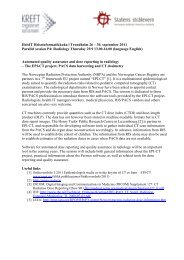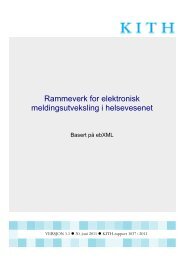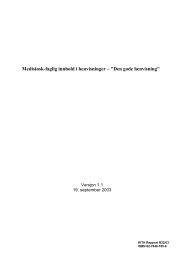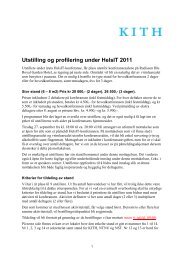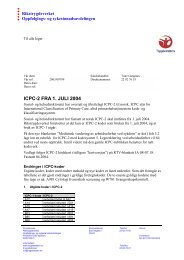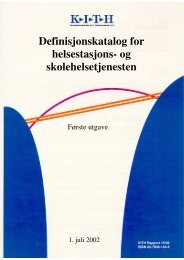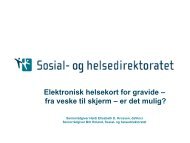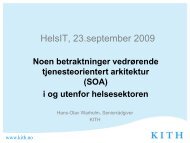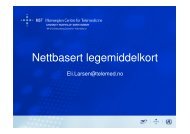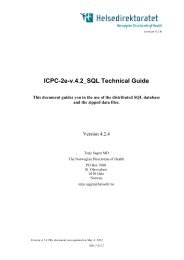Experiences from Ireland using archetype methodology for clinical ...
Experiences from Ireland using archetype methodology for clinical ...
Experiences from Ireland using archetype methodology for clinical ...
Create successful ePaper yourself
Turn your PDF publications into a flip-book with our unique Google optimized e-Paper software.
Archetype Research in <strong>Ireland</strong>(with a focus on records to supportbiomedical research)Damon BerryDublin Institute of Technology
Passing the baton (& EHR)Acute CarereferralCommunity InterventionsTeam (C.I.T.) Dublin NorthMater Hospital Two level model basedContinuing CareSt Marys Geriatric OPDreferralAssessmentToolDatabaseWeb applicationPrimary CareCommunity CareArea 6 and 7– PHN & DCTreferralPARTNERS TeamMs Lorraine McFeely, Ms Sue Paffrath (CIT)Ms Rosaleen Killalea(MMUH)Ms Mary Lee(DCT)Ms Anne McDonald, Ms Vicky Madden, Ms MaryKelly(Public Health Nursing)Ms Daragh Rodgers(St Marys)Ms Julianne Ballard, (Older person services)Mr Bevan Ritchie (Outreach CUH Temple St.)EHRland TeamDr Kathryn Hannah (Canadian Nursing Assoc.)Ms Janette Byrne (Patients Together)
Passing the baton: observations• The use of <strong>archetype</strong> editor was quite aheavy load <strong>for</strong> the members of the group• However, it brought user awareness of,– use of data types– coding, coded values, enumerations• Automatic user interface was generic– needs a lot of work to produce desired roundtrip experience <strong>for</strong> users
Use of<strong>archetype</strong>sandtemplatesIn CFproject
Archetypes <strong>for</strong> CF - observations• The ref model and <strong>archetype</strong> were foundto be sufficiently descriptive within thescope of this project.• This work underlined the dependencies<strong>from</strong> template to <strong>archetype</strong> and <strong>archetype</strong>to ref model.• High level of reuse – even with a relativelyimmature set of <strong>archetype</strong>s
Example 3: Archetypes <strong>for</strong>wound care (Gallagher – 2012)• MSc (HI) student who is an experiencedtissue viability nurse.• Recognised wound care documentationissues in Irish health system• Studied doc. practices “on the ground”• Researched best practice re documentation• Incorporated ideas based on this study intodraft <strong>archetype</strong> and submitted to CKM.
Example 4: Archetypes <strong>for</strong>biobanks (Spaeth – ongoing)• Growth in biomedical research accompanied bya growth in Biobanks containing large number ofwell annotated biological specimens data storedin biobank in<strong>for</strong>mation systems (BIMS)• High throughput automation has led to a hugeincrease in ‘omic’ in<strong>for</strong>mation.• But Omic research hampered by fragmentationof associated health in<strong>for</strong>mation
Archetypes <strong>for</strong> biobanks- research question• Is it practical to use openEHR to representa generic biomedical record that integrates<strong>clinical</strong> and research in<strong>for</strong>mation in asingle EHR?
Archetypes <strong>for</strong> biobanks -observations• The main obstacle that has emerged is theway that SPECIMEN is in the backgroundof two-level EHR reference models.• But <strong>from</strong> a biomedical research point ogview specimen is an example of asecondary identity, a “subject ofin<strong>for</strong>mation” rather than a “subject of care”• It is an example of a secondary identity.
2. Research on two levelmodels
Identity management andsecondary use
Patient and HCP: the two mainidentities in the record…PatientDoctorThese are the identities that EHR referencemodels focus on
… but <strong>for</strong> EHR reuse, others may berequiredCare IdentitiesPatientDoctorGeographical regionSecondaryuse identitiesBiological SampleResearcher
EHRcom (CEN13606)• Generic Fixed Demographics Model• Advantage– small enough to understand– Simple and efficient– identity in<strong>for</strong>mation can easily be stored in the genericstructures• Problem– like other standards (GEHR, HL7) standardisedgeneric domain in<strong>for</strong>mation structures, but no place toadd traits or new types of identity.
Demographics Package of CEN13606 RIMpreEN13606 Extract Reference Model v3FVDEMOGRAPHICS_PackageIDENTIFIED_ENTITY+extract_id: II+id: SETTELECOM+telecomAddress: URI+use: SETSOFTWARE_OR_DEVICE+desc: String[1]+manufacturerModelName: String[1]+code: CV[1]+version: String[0..1]IDENTIFIED_HEALTHCARE_PROFESSIONALowningOrganisationORGANISATION+code: CV[1]+desc: String[1]+name: String[1]+addraddrPERSONnameSUBJECT_OF_CARE_PERSON_IDENTIFICATION+administrativeGenderCode: CS+birthTime: TS+deceasedTime: TS+birthOrderNumber: Interger+role 0..*scopingOrganisation0..*POSTAL_ADDRESS0..*+postallCode: String+addressUse: SET+validTime: IVL0..*ENTITY_NAME+use: CV+validTime: IVLHEALTHCARE_PROFESSIONAL_ROLE+specialty: CV+id: SET+profession: CV+position_or_grade: CV0..*POSTAL_ADDRESS_PART+addressLine: String+addressLineType: CS+1..*ENTITY_NAME_PART+entityPartName: String+namePartType: CS+namePartQualifier: CS
Generalised Identity model(Chen ongoing):EntityidEntity = 10001idEntityDomain = 10001idEntityType = 10001idEntitLink =name = dmf_patstatus = Active:TraitidTrait = 1idEntity = 10001idTraitType= 12001simpleValue = 97CH87timeCreated = 2009-12-15 13:42:53TraitTypeidTraitType = 12001idEntityType = 10001name = hl7_PID_214.patient.iddescription = Patient Identifierof HL7 PID 2.14 profilesdataType = IIstatus = ActiveidTraitTypeSet = 120001:TraitTypeidTraitType = 12002idEntityType = 10001name = en13606.person.entity_name.usedescription = EN13606 Entity namedataType = CSstatus = ActiveidTraitTypeSet = 129001:TraitTypePartidTraitTypePart = 1idTraitTypeSet = 129001name = en13606.person.entity_name_part.entityPartNamedescription = (CEN 13606 RIM) The name part represented asa string.dataType = String
Generalised identity - Basic idea• Reference model stays fixed <strong>for</strong> parts ofdemographic model that are working <strong>for</strong>care process.• Allow certain general demographicsclasses to be <strong>archetype</strong>s– e.g. to allow creation of “subjects ofin<strong>for</strong>mation” <strong>for</strong> biomedical research
Archetypes and data quality
ISO EN 13606 – generic“bridge” between islands ofin<strong>for</strong>mationEPR XTwo-level EHREPR Y
“loose” vs “constrained” recordsLoose definitionreference modelEntryelementConstrained definitionreference modelEntryelementDifferent definitionsBlood pressuresystolicdiastolicmeanorBlood pressuresystolicdiastolicpostureactivity+ Archetype rules(if blood pressure,1) must have systolic, diastolic, posture, activityelements2) posture must be one of {sitting, standing lying}3) activity must be one of ….Single definitionBlood pressuresystolicdiastolicposture {sitting, standing, …}activity {…}25
Data Quality• Data or in<strong>for</strong>mation quality refers to the degreeto which data are suitable <strong>for</strong> a specificpurpose.• Data quality assessment is commonly applied toaggregated or shared data – which have variedlevels of completeness, timeliness, accuracy,consistency, accessibility…• the data quality of shared health in<strong>for</strong>mation inan EHR should be of interest.• But also the quality of health in<strong>for</strong>mation duringsecondary use - e.g. when merged with biobankdata



